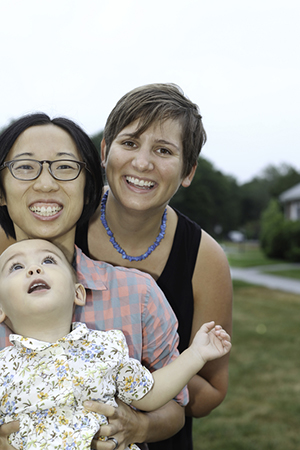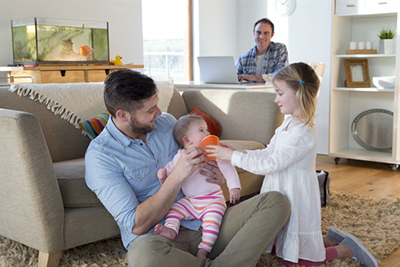 The International Lesbian and Gay Association (ILGA) has identified the UK as the most progressive country in Europe for LGBT+ rights. British Social Attitudes Reports show that over the past 25 years there have been rapid and predominantly positive socio-cultural and legal changes and the National Survey of Sexual Attitudes and Lifestyles (NATSAL) indicates that experience of and acceptance of lesbian and gay sexualities is greater than ever before. Key legislative changes underpin and derive from these attitudinal shifts and there are now more parenting opportunities available than ever before. Sexual orientation and relationship status are no longer delimiting factors in gaining access to assisted reproduction or adoptive parenthood. Lesbian and gay couples can accrue legal recognition of their partnerships through civil partnership legislation and same-sex marriage. Financial and relational benefits are bestowed upon couples who can afford and/or want to take advantage of these opportunities. This socio-legal sea change has transformed the contemporary landscape of queer lives and loves; parenting possibilities are now part of the imagined futures of LGBTQ+ relationships.
The International Lesbian and Gay Association (ILGA) has identified the UK as the most progressive country in Europe for LGBT+ rights. British Social Attitudes Reports show that over the past 25 years there have been rapid and predominantly positive socio-cultural and legal changes and the National Survey of Sexual Attitudes and Lifestyles (NATSAL) indicates that experience of and acceptance of lesbian and gay sexualities is greater than ever before. Key legislative changes underpin and derive from these attitudinal shifts and there are now more parenting opportunities available than ever before. Sexual orientation and relationship status are no longer delimiting factors in gaining access to assisted reproduction or adoptive parenthood. Lesbian and gay couples can accrue legal recognition of their partnerships through civil partnership legislation and same-sex marriage. Financial and relational benefits are bestowed upon couples who can afford and/or want to take advantage of these opportunities. This socio-legal sea change has transformed the contemporary landscape of queer lives and loves; parenting possibilities are now part of the imagined futures of LGBTQ+ relationships.
Choice, however, is not freely available and socio-economic and educational resources continue to inform the experience of queer kinship. Moreover, the rights that have been won may not be universally welcomed by all within the LGBTQ+ community. Marriage rights present ‘the couple’ as the primary legitimate partnership form; parental rights and family responsibilities place queer bodies within the heteronormative reproductive order. Here kinship ideologies symbolise both permanence and authenticity and, by default, render all other relationship forms and sexual lifestyles as fleeting and illegitimate. In this article I will explore how same-sex parenting and partnering have changed over the past 25 years and some of the issues that are at stake in this progressive narrative.
There is no doubt the LGBTQ+ community has come a long way. Lesbian motherhood was previously characterised by divorce narratives and ill-fated custody disputes. At its worst in the 1970s and 80s, around 90% of lesbians in the UK were losing their children in contested custody cases (Rights of Women Custody Group 1986). Lesbianism and parenthood were deemed incompatible. Lesbian mothers were unfit to be parents and posed a potential risk to daughters whom they might corrupt or even desire. They were presented with an untenable choice: children or sexuality.
The cultural possibility of lesbian and gay parenthood paradoxically emerged in the mid-1980s from a discriminatory policy that sought to outlaw queer families. In May 1988 the Conservative government introduced Section 28, a Local Government Act that prohibited any local authority to ‘promote’ homosexuality and/or ‘pretended family relationships’. The ‘Stop the Clause’ campaign that was mounted against the Act was intended to provoke its removal from the statute books. It was therefore unsuccessful to some extent as Section 28 was only repealed in June 2000 in Scotland and November 2003 for the rest of the UK. In other ways however it far exceeded expectations. The campaign fostered community through collective outrage and raised public awareness of same-sex relationships; showing that queer parenthood was not only possible, it was already happening. Hiding the possibility of queer parenthood in plain site was a serendipitous educational opportunity. This period blossomed into the so-called ‘gayby boom’ with community-produced pregnancy manuals (such as Saffron 2001) providing the information women needed to create families and keep them.
Research commissioned by the Equality and Human Rights Commission (2008) recognises that is hard to discern from national population datasets the numbers of children living in LGBTQ+ parent households in the UK today, because sexual diversity did not feature in the Integrated Household Survey (IHS) until 2010, long after Section 28 (1988) and the 1990s ‘gayby boom’. Notwithstanding this gap in statistical evidence, the number of households headed by LGBTQ+ parents is undoubtedly increasing and the resultant queer kinship reflects every hue of the family rainbow. Queer parenting opportunities have advanced through donor insemination (DI) and in vitro fertilisation (IVF) being made available for lone mothers (2005) and same sex couples (2009); similarly so adoption. Rights and liberal rules do not however equate with limitless choice. Parental decision-making typically segues into understandings of ‘the best choice’, and in the UK this is eliding with ‘compulsory coupledom’ (Wilkinson, 2012). Settling down, committing to a partner for the long-term, getting ‘married’, and ‘starting a family’ are now routine pathways in a queer life trajectory.
There is great appetite amongst the lesbian and gay population to ‘tie the knot’ and register their partnerships as a legal union. For many, the desire to build a home and start a family together now underpins the couple project, embedding futurity into the very construct of the queer household. What drives these changes and social tolerance more generally is, arguably, not a particular investment in the rights and wrongs of LGBTQ+ sexuality; instead it is the intensification of parenthood (Lee et al 2014) that drives the UK intimate agenda. A new normative family has emerged, one that revolves around the dyadic adult couple whose relationship is oriented around parental responsibilities which prioritise ‘work, economic self-sufficiency, education and good behaviour’ (Williams 2005: 244). UK cross-party interest remains focussed on parenting and families with children. From New Labour government (1997–2010) initiatives such as Every Parent Matters and Support for All: Families and Relationships through to Conservative-Liberal Democratic coalition government (2010–2015) reforms, including the Children and Families Act (2014). In popular discourse ‘hard working families’ are the priority; dual-headed (read dual income) households are characterised as best placed to meet children’s emotional and practical needs. Conservative Government ‘Marriage Allowance’ tax allowances reward couples who are willing to work at their relationships.
 Young LGBTQ people in 21st century UK have grown up in an era where same-sex marriage and potential parenthood are legal rights. Whilst earlier iterations of ‘families of choice’ (Weston 1997) drew attention to the cultural artifice of blood ties, today bio-genetic discourses suture the parent–child relationship and evidence the permanence of commitment and feelings therein. Starting a family together facilitates entry into the symbolic realms of authentic reproductive citizenship: biological ties simultaneously solidify the past, present and future of both parental and partner relationships. It is therefore perhaps not surprising that the queer community remains divided by the rise of such ‘equality of opportunity’. Whilst ONS (2015) report a decline in ‘marriage’ rates, initial uptake of civil partnership far exceeded assessments made in the Civil Partnership Act (2004). It was calculated that 11,000-22,000 people would register a civil partnership in the initial five years; instead the uptake reached nearly 107,000 by 2011, nearly tenfold that number.
Young LGBTQ people in 21st century UK have grown up in an era where same-sex marriage and potential parenthood are legal rights. Whilst earlier iterations of ‘families of choice’ (Weston 1997) drew attention to the cultural artifice of blood ties, today bio-genetic discourses suture the parent–child relationship and evidence the permanence of commitment and feelings therein. Starting a family together facilitates entry into the symbolic realms of authentic reproductive citizenship: biological ties simultaneously solidify the past, present and future of both parental and partner relationships. It is therefore perhaps not surprising that the queer community remains divided by the rise of such ‘equality of opportunity’. Whilst ONS (2015) report a decline in ‘marriage’ rates, initial uptake of civil partnership far exceeded assessments made in the Civil Partnership Act (2004). It was calculated that 11,000-22,000 people would register a civil partnership in the initial five years; instead the uptake reached nearly 107,000 by 2011, nearly tenfold that number.
For some this interest in same-sex unions represents a symbolic rupture between the institutions of marriage and heterosexuality (Weeks, 2007). Other socio-legal scholars offer words of caution, suggesting that without wider recognition of sexual inequalities that problematize the status quo LGBTQ+ entitlements may conversely consolidate heteronormativity rather than undo it (Rahman 2000). For others same-sex marriage represents assimilation, transforming transgressive queer eros into dull rituals that reproduce heteronormative citizenship (Brandzel 2005). This is to oversimplify the debate and there are many areas of consensus. What is clear though is that same-sex unions have neatly deposited queer parenthood in the inner sanctum of what Gayle Rubin (1984) called the ‘charmed circle’. Here ‘good’ and ‘bad’ sex are ordered according to their cultural value and moral meanings. The legally sanctioned couple partnership and the parental figure are situated in contradistinction to sexual minority deviants who resist the citizenship rights that are on offer.
Over the past generation (1990-2015) in the UK there have undoubtedly been significant and important advancements in both equality rights and positive social attitudinal changes. The passage of queer parenthood across this generation is not, however, straightforward and many of the ‘choices’ on offer are not freely available. Routes into parenthood may be proliferating, but they also remain grounded in the materiality of circumstances which can and does delimit what is available and/or imaginable. The Adoption and Children Act (2002) does afford lesbian and gay people the right to adopt (individually and as partners), and the UK is presently one of only 14 countries where such same-sex couple adoption is a legally available option; however, for those who want to conceive a child the resources required are not insignificant. Donor insemination (DI) costs £500-£1000 for six cycles of treatment. In vitro fertilisation (IVF) is available on the NHS but access to this service is tied to strict eligibility criteria, such as previous DI attempts, age, and general health indicators. Private IVF is prohibitively expensive for most and can cost over £5000 per cycle of treatment. For those without access to financial resources, the cultural norm that promotes parenthood may be leading to unregulated and potentially unsafe routes into parenthood (Nordqvist and Smart, 2014).
So before we herald the ‘world we have won’ (Weeks 2007), it is worth reflecting on to extent to which this simultaneously liberates and constrains us.
- As respectability and responsibility have become embedded in sexual citizenship rights, what are the cultural and relational costs?
- Who gets excluded by equality of reproductive opportunity?
- How have commitment and regulatory norms shut down queer relationship possibilities
Whilst Britain may appear to be one of the most progressive countries for LGBTQ+ rights, reproductive possibilities are not cost-neutral. We should be wary of conflating temporal progression, progressive rights and narratives of progress. Time may march forward: rights may be progressive; but reconciling attitudes and feelings is seldom straightforward.
Rate and Review
Rate this article
Review this article
Log into OpenLearn to leave reviews and join in the conversation.
Article reviews